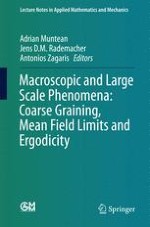
2016 | OriginalPaper | Buchkapitel
1. On the Dynamics of Large Particle Systems in the Mean Field Limit
verfasst von : François Golse
Erschienen in: Macroscopic and Large Scale Phenomena: Coarse Graining, Mean Field Limits and Ergodicity
Aktivieren Sie unsere intelligente Suche, um passende Fachinhalte oder Patente zu finden.
Wählen Sie Textabschnitte aus um mit Künstlicher Intelligenz passenden Patente zu finden. powered by
Markieren Sie Textabschnitte, um KI-gestützt weitere passende Inhalte zu finden. powered by
Abstract
This course explains how the usual mean field evolution partial differential equations (PDEs) in Statistical Physics—such as the Vlasov-Poisson system, the vorticity formulation of the two-dimensional Euler equation for incompressible fluids, or the time-dependent Hartree equation in quantum mechanics—can be rigorously derived from the fundamental microscopic equations that govern the evolution of large, interacting particle systems. The emphasis is put on the mathematical methods used in these derivations, such as Dobrushin’s stability estimate in the Monge-Kantorovich distance for the empirical measures built on the solution of the N-particle motion equations in classical mechanics, or the theory of BBGKY hierarchies in the case of classical as well as quantum problems. We explain in detail how these different approaches are related; in particular we insist on the notion of chaotic sequences and on the propagation of chaos in the BBGKY hierarchy as the number of particles tends to infinity.